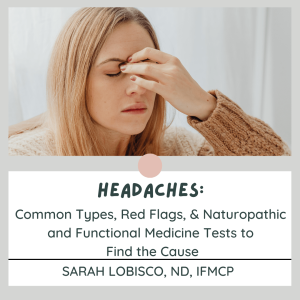
Most common in the 25–40 years old age group, about 96% of the population have reported having a headache. No one likes to experience this annoying, throbbing, constant dull or sharp pain in the head or face.
The good news is that the majority of headaches are often not serious. Still, they can impact quality of life and be a major source of aggravation. Often triggers such as stress, hormones, or gut imbalances are involved.
When the underlying issue is not clear, or the headaches are complex, lab tests can assist a practitioner in determining the most likely reasons one is suffering with head discomfort. Combining this objective information with a patient’s history and symptoms brings to focus the most important areas to make them stop.
In my latest post and video on headaches, I review the common types, how to know when they are serious, and functional and naturopathic medicine tests to help find the cause. I discuss the following topics about headaches:
- Classifications (primary and secondary)
- Common types (tension, migraine, and cluster)
- Causes
- Red flags that signal the need for prompt medical attention (the “SNOOP” acronym)
- Functional medicine tests to consider if the cause of them is not clear
Click here to learn more about headaches.
In an upcoming article, I’ll review some naturopathic and functional medicine approaches to soothe an aching head.
Naturopathic Medicine and Holistic Resources for Hormone, Digestive, and Mood Support

- Free resources and more education on essential oils and mind-body wellness are available to you here.
- Tools for coping with isolation and separation.
- My community membership program with full access to my essential oils database, essential oils course, Q&As, and exclusive content.
Stay Connected! Sign-up for my free weekly newsletter.
Disclaimer: This material is for information purposes only and is not intended to diagnose, treat, or prescribe for any illness. You should check with your doctor regarding implementing any new strategies into your wellness regime. These statements have not been evaluated by the FDA.
This information is applicable ONLY for therapeutic quality essential oils. This information DOES NOT apply to essential oils that have not been tested for purity and standardized constituents. There is no quality control in the United States, and oils labeled as “100% pure” need only to contain 5% of the actual oil. The rest of the bottle can be filled with fillers and sometimes toxic ingredients that can irritate the skin. The studies are not based solely on a specific brand of an essential oil, unless stated. Please read the full study for more information.



